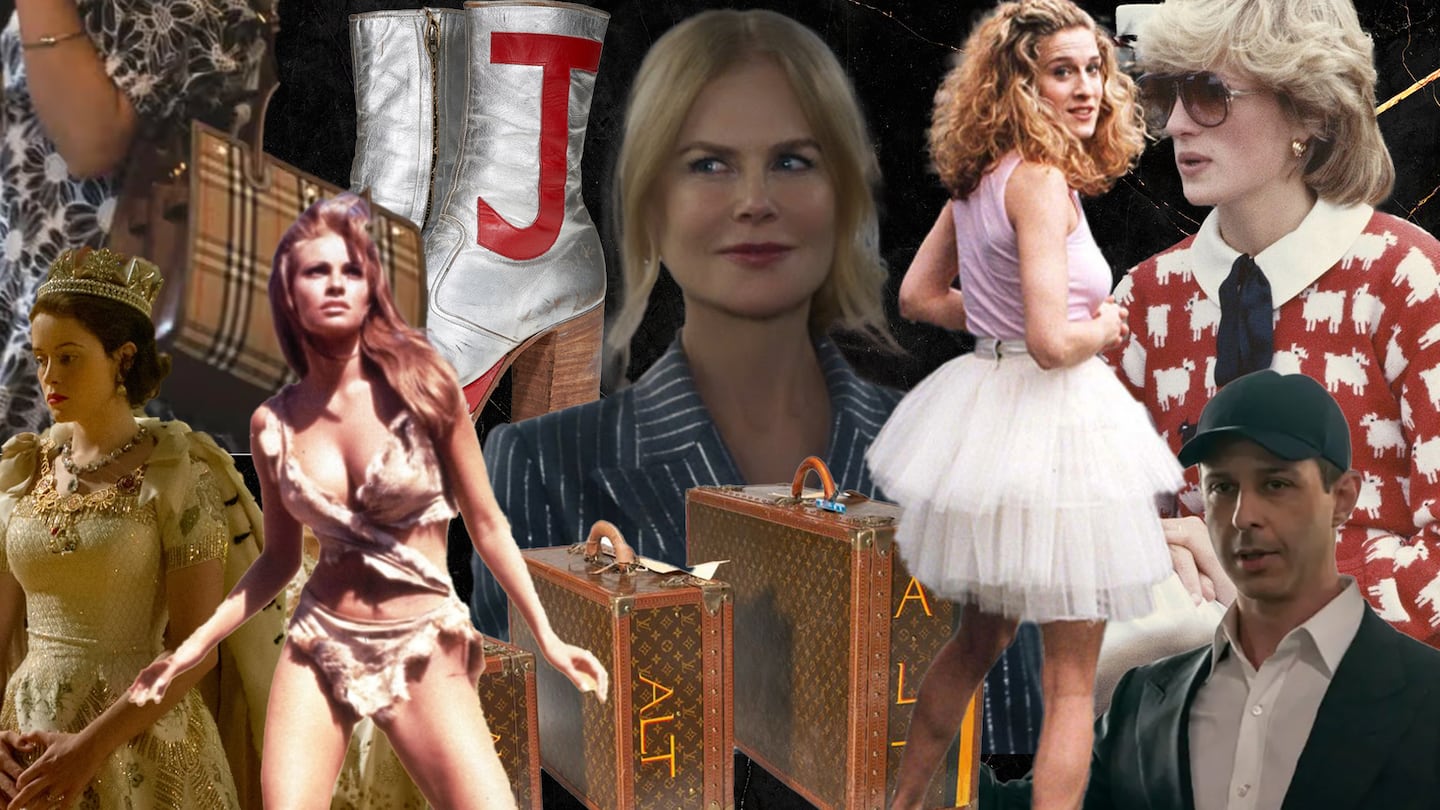
The Business of Fashion
Agenda-setting intelligence, analysis and advice for the global fashion community.

Agenda-setting intelligence, analysis and advice for the global fashion community.

There’s a lot of talk about luxury’s rising prices, but it’s at auction that fashion is selling for the most eye-popping of sums.
In 2022, Celine sunglasses owned by Joan Didion sold for $27,000, and in 2023 a pair of Levi’s once worn by Nirvana frontman Kurt Cobain fetched $412,750. Last month, Elton John’s diamond encrusted, leopard-print Rolex sold for $176,400. Those sums, however, are paltry when compared to the sale of Princess Diana’s black sheep sweater, which went for $1.14 million last year.
Fashion items from the sets of TV, film and even commercials can also garner high prices. This year alone, the so-called “ludicrously capacious” Burberry bag from “Succession” sold for $18,750; the suit Nicole Kidman wore in her viral AMC Theatres ad went for $9,525 and an auction of costumes and props from “The Crown” brought in a collective $2.1 million.
Over the past decade, fashion has become more of a priority for top auction houses such as Sotheby’s, Bonhams and Christie’s, playing a key role in their strategy to attract a new generation of customers, who can place their bids online.
ADVERTISEMENT
“Now as long as you have the money — and you have to have the money — anyone can participate,” said Lucy Bishop, Sotheby’s handbags and fashion specialist.
While selling prices are widely publicised, the buyers behind those sums are usually kept quiet. Auction houses maintain something akin to attorney-client privilege when it comes to the identities of their bidders.
Those buyers, in actuality, range from museums to private collectors to one-off fans. Many buy with the hope of a significant return on their investment, for others, the possibility is just a bonus. Most trace their desire to own a piece to some long-held passion — actually owning the rare item is only part of the allure.
“The collecting process and the hunt is even more gratifying than the conquest,” said Miles Nadal, an entrepreneur who operates “Dare to Dream” museum in Toronto, which displays items including sneakers worn during Michael Jordan’s “Last Dance” with the Chicago Bulls and Nike’s original “Moon Shoe.”
There isn’t a simple answer to where fashion items end up after they’re sold at auction, but buyers typically fall into a few buckets: museums and institutions; private collectors; vintage dealers and super fans.
The more significant the item, the pool of potential buyers shrinks. “This world is a very exclusive club where those in the know really know,” said Bishop.
The most historically important pieces — whether because of their tie to a particular designer, era in fashion history or because they were worn by the likes of figures such as Audrey Hepburn or Princess Diana — are usually scooped up by institutions like London’s Victoria & Albert Museum and New York’s Metropolitan Museum of Art. Even if they’re bought by private collectors, they still may end up in a museum display — on loan.
Celebrities themselves often do the buying: Lady Gaga and Kim Kardashian have bought Michael Jackson’s clothing, for example. They help publicise their purchases, too: actress Laverne Cox is known to sport her own Mugler collection on the red carpet. In fact, much of the archival fashion seen on stars today has passed through auction.
ADVERTISEMENT
“Fashion auctions have been Hollywood stylists’ best kept secret for a few decades but that secret is now definitely out,” said Bishop.
People who pursue iconic items — celebrity-owned or not — do it out of passion.
“All it takes is a certain attachment to a specific designer,” said Shannon Hoey, a vintage fashion dealer whose expansive archive was largely acquired through auctions. Hoey works with designers on references for their collections and stylists to place pieces on the red carpet, in editorials and on the big screen.
For others, it’s a connection to a notable public figure or cultural asset. Because those items often sell at mark-up — a 2019 Lady Dior handbag carried by Elizabeth Debicki as Princess Diana in “The Crown” went for upwards of $12,000 rather than the typical $4,000 — it’s fans, not fashion purists, who usually do the purchasing, said Meg Randell, head of fashion and handbags at Bonhams.
Leigh Anne Clark — a Dallas-based Valentino, Saint Laurent and Chanel shopper — snagged Andre Leon Talley’s Birkin at Christie’s last year.
“It probably sat next to Anna Wintour on a plane going somewhere cool for a shoot I probably looked at in the magazine,” said Clark. “It feels like I understood a part of [Talley], or if he had known me he would’ve understood part of me.”
She plans to display it in a closet, rather than use it regularly.
California-based teacher Renae Plant, meanwhile, has acquired 89 Princess Diana pieces including the Versace dress she wore on the cover of Harper’s Bazaar, acquired in 2015 for $200,000 and USA sweatshirt she gifted to a dock worker before her death in Paris. Her love for the late royal began in childhood, when she shook Diana’s hand during her 1983 visit to Australia.
ADVERTISEMENT
Plant operates a website, but has her sights set on staging a major exhibit. For now, the clothes are locked away in a climate controlled storage facility in California.
“Her life has such meaning, I wanted to tell her story,” said Plant. “It’s about her kindness and her ability to make you feel like you’ve known her for years even though you just touched her hand.”
The potential for big returns attracted a new sort of fashion buyer to auctions — those who look at the category as an investment, or who Martin Nolan, executive director of Julien’s Auctions, which focuses on celebrity-owned items and memorabilia, calls the “hedge fund manager.”
Those buyers are particularly interested in celebrity-linked pieces, which attract press attention, a wide range of buyers and often higher valuations. When an item is attached to a hit film, it usually makes it easier to sell. Hoey, for example, placed the taxidermy bird Carrie Bradshaw wore to her would-be wedding in the “Sex and the City” movie, and then sold it at Sotheby’s for $25,400 in 2023.
Meanwhile, the next round of big ticket items are always being minted — on stages and behind the scenes. Whispers about who will get their hands on the fashions from the “Barbie” film are already swirling, said Nolan.
The next big sale might even be an item that’s already fetched a hefty sum, as new circumstances or just the passage of time could add value. After Kim Kardashian wore the dress Marilyn Monroe wore to sing happy birthday to President John F. Kennedy dress to the 2022 Met Gala, some said she jeopardised the dress’s integrity, while others argued she added new weight to the garment, which has already seen its value more than triple from selling for $1.27 million in 1999 to $4.8 million in 2016.
“That dress would now sell for $10 million because of that double whammy connection of a celebrity,” said Nolan.
The designer and CFDA chairman will front the auction house’s January sale of American paintings, furniture, ceramics and other objects, including a fashion selection in partnership with the CFDA, meant to hammer home the idea of American fashion as art, said Browne.
A collection of rare Gucci handbags failed to fetch expected prices, a sign that robust demand for high-end purses is softening
Traditional auction houses like Christie’s, Sotheby’s and Philips — known for selling Warhols, Picassos and antiques — are using Birkins and Jordans to cultivate their next generation of collectors.

Joan Kennedy is Editorial Associate at The Business of Fashion. She is based in New York and covers beauty and marketing.
The designer has always been an arch perfectionist, a quality that has been central to his success but which clashes with the demands on creative directors today, writes Imran Amed.
This week, Prada and Miu Miu reported strong sales as LVMH slowed and Kering retreated sharply. In fashion’s so-called “quiet luxury” moment, consumers may care less about whether products have logos and more about what those logos stand for.
The luxury goods maker is seeking pricing harmonisation across the globe, and adjusts prices in different markets to ensure that the company is”fair to all [its] clients everywhere,” CEO Leena Nair said.
Hermes saw Chinese buyers snap up its luxury products as the Kelly bag maker showed its resilience amid a broader slowdown in demand for the sector.